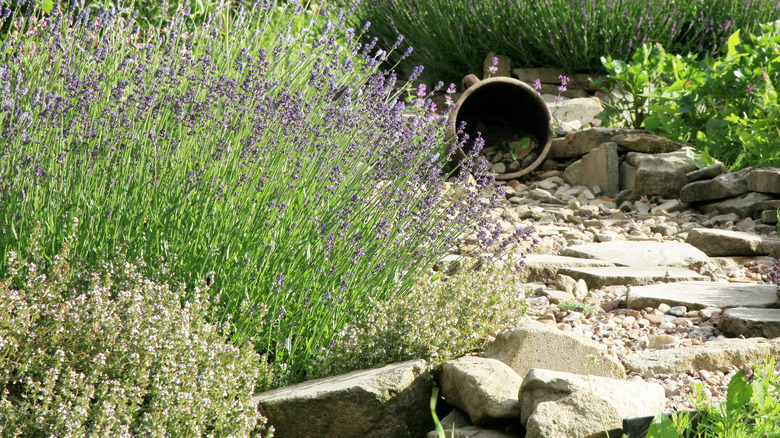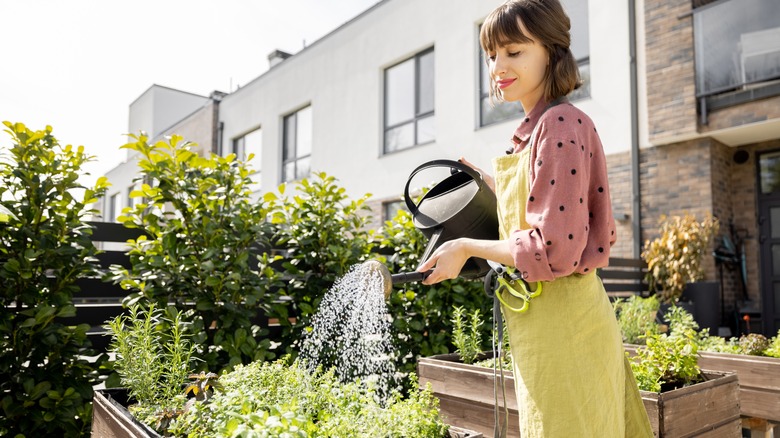A wide range of herbs can be used together, whether you’re baking or making a flavorful meal. And while not all can grow in the same environment and thrive at the same level, some work very well as companion plants — including thyme and lavender. That means they need a similar environment to do well and, therefore, work to support each other’s growth. They also both help draw in pollinators to support ongoing growth throughout the year.
Thyme (Thymus) is a smaller, robust, fragrant shrub. You can easily grow this evergreen plant in a container near your kitchen window, but consider planting it in the garden. Its strong aroma works as a deterrent for some pests, while its tiny flowers can bring in pollinators. Choose from numerous varieties of thyme to get the results you want. Some forms, like creeping thyme, do well to stay low to the ground, creating a beautiful addition to your garden.
Coupling thyme with lavender (Lavandula) is an excellent choice. It’s a fantastic attractant for pollinators, especially bees and butterflies. With a soft, floral scent, this herb works well for crafts, various teas, savory dishes, and even a few organic soaps. With the right environment, it’s also a low-maintenance ground cover that adds a soft, purple color to your space.
Create the perfect environment for thyme and lavender

Lavender and thyme have similar growing needs. Lavender does well in full sun, while thyme also benefits from ample light throughout the growing season. While both plants can be grown in containers in your home, they tend to do better with ample sun in a garden space. You can plant both from seeds or seedlings, typically in late spring or early summer, once the threat of frost has passed.
The next consideration is soil, which should be well-draining and, when possible, rather loose for both plants. This allows the thinner root system of these varieties to grow quickly and create a strong foundation. If your soil is heavy with clay, mix in some sand to improve drainage. Aim for soil that’s slightly alkaline for both plants, with a pH range of 6.7 to 7.3. To supplement the growth of thyme and lavender, add organic matter — this can help the soil to support ongoing growth throughout the year.
It’s also a good idea to space out these plants about 1 to 3 feet from each other. Depending on the varieties of lavender and thyme that you choose, they could spread quickly, requiring more space to reach their full potential. You also want to keep the airflow good to help minimize standing water, and keeping the area open aids in that process. Some varieties are much smaller, doing well in a container on your patio.
Support these plants throughout the growing season

Once your herbs are planted, they need a bit of continuous care throughout the year to keep them thriving. Both herbs benefit from ongoing feeding throughout the season. Start by mixing organic material into several inches of soil and spread it along the base of the plants. You can also use a water-soluble plant food to add nutrients to the soil every few weeks.
In all situations, moisture is a must. Both lavender and thyme need moisture and will struggle under high heat without moist soil. Water every few days, specifically when the top inch of the soil becomes dry. But monitor lavender closely — this is a more drought-tolerant plant that doesn’t like too much moisture. With this in mind, you’ll want to keep the soil these two share moist but not drenched or soggy. As they grow, you’ll be able to prune their leaves to use as you would like, such as for drying or to add to a dish you’re making. Neither plant needs to be staked, and both begin to produce leaves that you can prune within the first few weeks of summer. Most will have a second flowering if you deadhead them (depending on the variety of lavender chosen).
Depending on your climate, you could continue to see lavender and thyme thrive well into the fall, with some varieties of thyme remaining evergreen. You can trim, dry, refrigerate, or steep these herbs in oil to preserve and use their flavor throughout the year.



